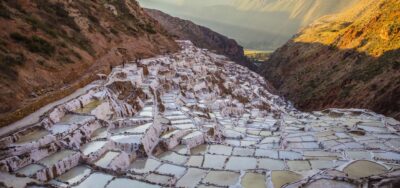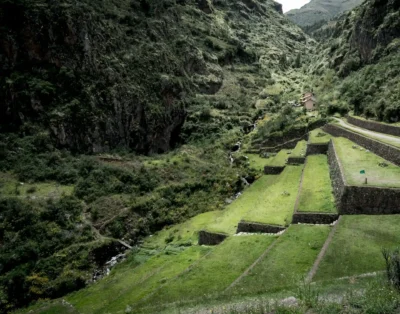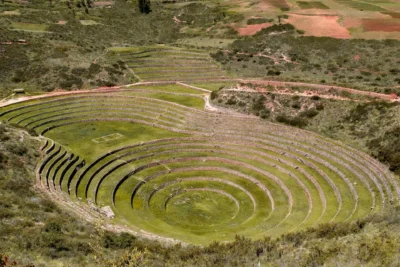If you are planning a trip to Cusco, you are probably wondering which places you cannot miss. One of those destinations is Chinchero, a small picturesque town full of history, culture, and traditions that will take you back to the time of the Incas. Known for its scenic beauty and rich heritage, Chinchero is famous for both its archaeological sites and its traditional market, where Andean colors and textiles create a beautiful visual experience.
At Machu Picchu Wayna, we provide everything you need to know to fully enjoy Chinchero: from its history and places of interest to how to get there and what to see.
What is Chinchero?
It is a charming Andean town located in the Sacred Valley of the Incas, just 28 kilometers from Cusco. This place, which combines mountainous landscapes with colonial architecture and Inca remains, is an interesting stop for travelers looking to explore Peruvian history and culture. Chinchero is known for its traditional market, its archaeological ruins, and its vibrant textile tradition, which has been preserved and passed down from generation to generation. The town is also famous for its agricultural terraces, which the Incas used for farming.
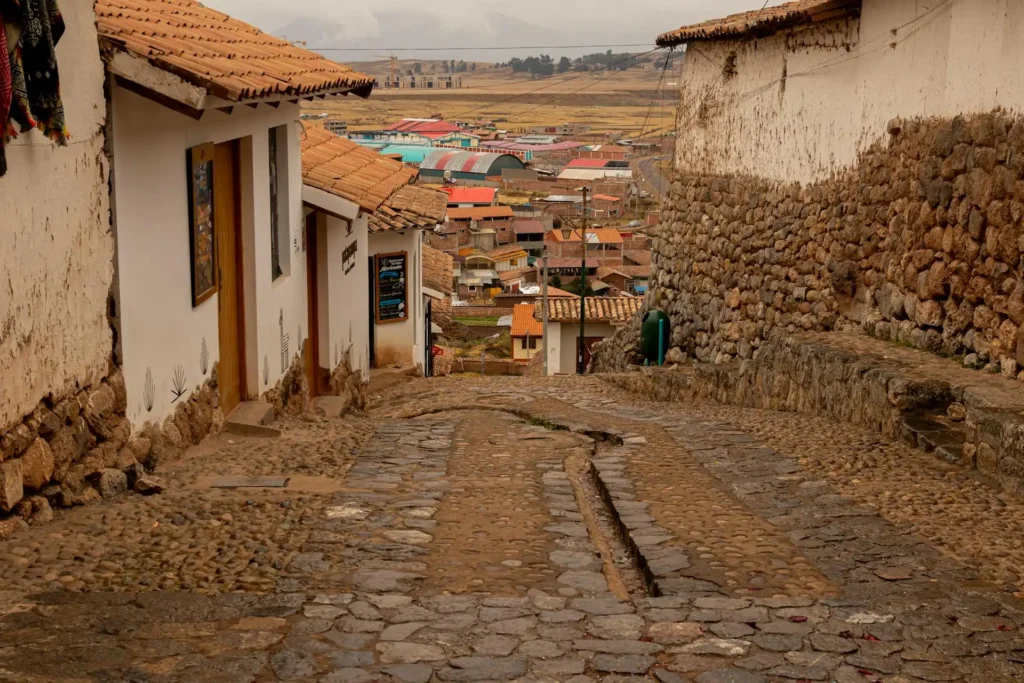
What does Chinchero mean?
The name Chinchero comes from Quechua. It is believed that Chinchero is related to the word “Chinchay” or “Chinchayco,” which means “puma” in Quechua, a sacred and symbolic animal in the Andean worldview. This name could refer to the presence of this majestic feline in the region or to the spiritual connection with the strength and power it represents in Inca culture.
Another associated meaning is that Chinchero could also derive from “chinkay” (meaning “death” or “to bury”), suggesting a connection with ancient rituals or historical events linked to the place, although this interpretation is less common. However, the first version, related to the puma, is the most widely accepted.
Difference between Chinchero and Chincheros
The difference between Chinchero and Chincheros lies in the correct use of the name. Chinchero is the official name of the town, known for its Inca legacy, its traditional market, and its archaeological site. The term Chinchero comes from the Quechua word “Chinchay,” related to the puma, an important animal in the Andean worldview. On the other hand, Chincheros is an incorrect variant or typographical error of the name and should not be used to refer to the place, as the correct form is Chinchero.
History of Chinchero
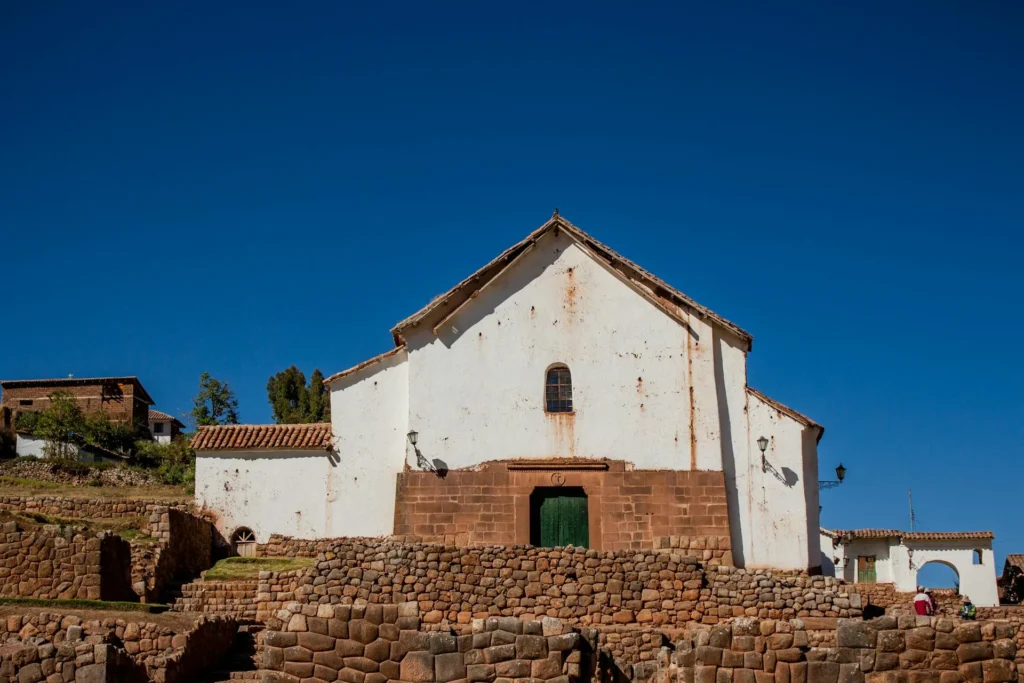
Pre-Inca Period
Before the arrival of the Incas, Chinchero was already inhabited by various Andean cultures that used the area’s fertile land for agriculture. Archaeological remains show that this place has been a center of human activity since ancient times due to its strategic position in the Sacred Valley and its connection with other communities.
Inca Period
Chinchero was a strategic location during the Inca era, both for its location and its agricultural wealth. According to historical tradition, it was a royal resting place established by Inca Túpac Yupanqui in the 15th century. This ruler built agricultural terraces, aqueducts, and a royal palace in Chinchero, demonstrating the importance of this site within the empire.
The name “Chinchero” comes from the Quechua words “Chinchay” or “Chinchaysuyo,” referring to the northwestern region of Tahuantinsuyo and also associated with the puma, a sacred feline in the Andean worldview.
Colonial Period
With the Spanish invasion in the 16th century, Chinchero underwent significant transformations. In 1572, Viceroy Toledo promoted the reduction of indigenous populations, reorganizing settlements to facilitate colonial control. In this process, ancient Inca temples were destroyed or repurposed as foundations for Catholic buildings.
The current Church of Our Lady of Monserrat, built in 1607, was erected over the remains of Túpac Yupanqui’s palace. This church, declared a Cultural Heritage Site, is an example of the syncretism between Andean and Spanish cultures, as it houses frescoes and decorations that blend European religious motifs with native elements.
Chinchero Today
Today, Chinchero is a tourist destination that attracts visitors from many places. The handicraft and textile market is famous for the quality and authenticity of its products, and the archaeological site provides insight into the life and beliefs of the Incas. Despite its tourist popularity, Chinchero has managed to preserve its traditional essence, and its inhabitants continue to uphold many ancestral customs.
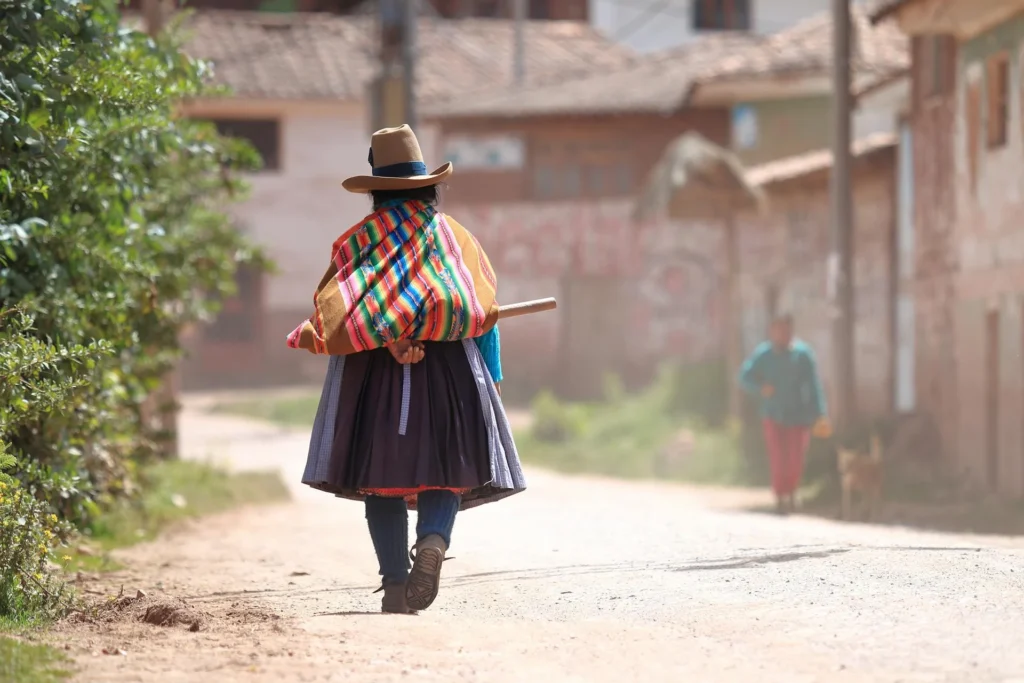
Textile Tradition and Living Culture
Despite Spanish colonization, the people of Chinchero preserved their traditions. To this day, the town is famous for its textile art, an ancestral heritage that remains alive. Chinchero’s textiles are made from alpaca and sheep wool, dyed with natural pigments such as cochineal, indigo, and chilca.
The Sunday market in Chinchero, dating back to pre-Hispanic times, remains an important center for commercial and cultural exchange. Here, locals practice barter (exchange of goods) and sell their textiles and handicrafts, keeping the essence of their past alive.
Where is Chinchero?
It is located in the Sacred Valley of the Incas, in the Cusco region, approximately 30 kilometers from Cusco city, at an altitude of 3,762 meters above sea level.
This picturesque town sits on a hill, offering stunning views of the surrounding landscapes, including the Sacred Valley and nearby mountains. Chinchero is in the Chinchero district, within the Urubamba province, and is an important stop for tourists traveling to the Sacred Valley on their way to Machu Picchu.
How to Get to Chinchero from Cusco?
Getting to Chinchero from Cusco is easy and can be done in different ways, depending on your budget and preferences. Here are some options:
- Public transport (minivans or interprovincial buses): Head to the bus and van terminal on Pavitos Street or Grau Avenue in Cusco, and they will take you to Chinchero in about one hour. This is a budget-friendly option for independent travelers.
- Taxi: You can also take a taxi from Cusco, which will take you directly to Chinchero in about 40 minutes. This option is faster and more comfortable, although more expensive than buses.
- Guided tour: If you prefer a more complete experience, many tours from Cusco include Chinchero along with other stops in the Sacred Valley, such as Moray and the Maras Salt Mines. Tours usually include transportation, a guide, and free time to explore.
Pros and Cons of Traveling by Bus
Pros:
- It is the cheapest option.
- Buses are frequent throughout the day.
- Allows an authentic experience, traveling with locals.
Cons:
- It can be uncomfortable if crowded or if carrying luggage.
- Schedules are not fixed, especially in the afternoon.
- Buses do not go directly to the archaeological site; you will need to walk or take another local transport.
Places of Interest in Chinchero
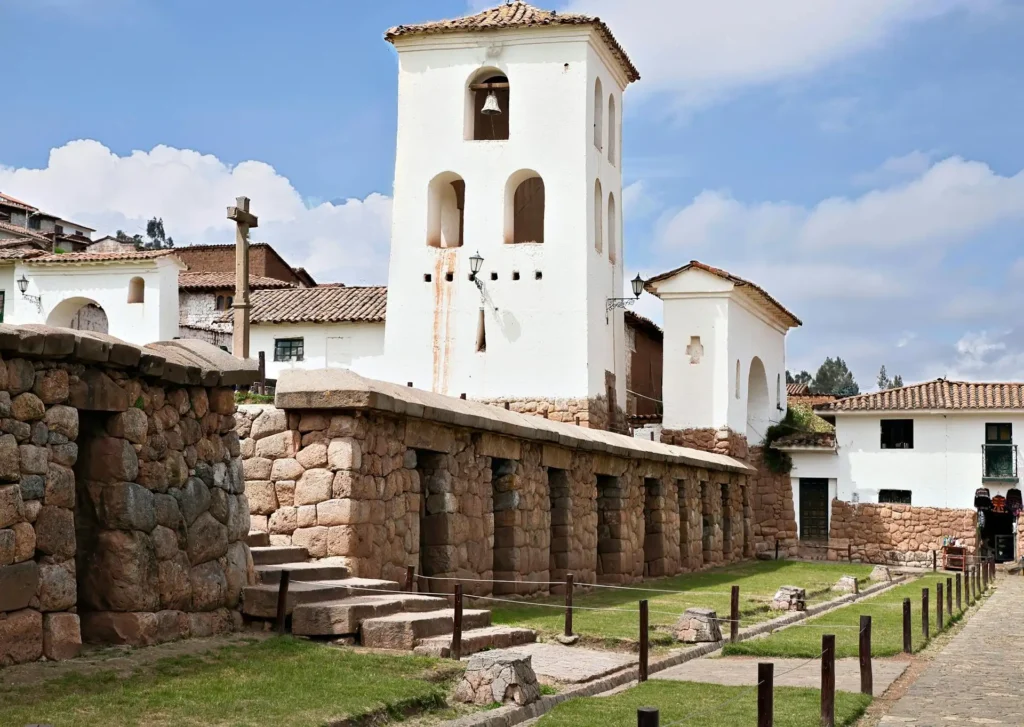
Chinchero Archaeological Site
This Inca site is characterized by its agricultural terraces built to cultivate products such as corn, potatoes, and other typical regional crops. The terraces are arranged on the mountain slopes and are maintained thanks to an ingenious irrigation channel system that still functions today.
Additionally, the site features remains of Inca dwellings and temples that were used for religious ceremonies. The site also houses a main square, where the Incas carried out social and ceremonial activities. From the archaeological center, there is an impressive panoramic view of the Sacred Valley.
Chinchero Market
It is one of the most authentic in Chinchero and an excellent place to experience the daily life of Andean villages. In this market, local artisans sell handmade crafts, especially textiles created with traditional techniques passed down from generation to generation. The colors and designs of these fabrics have specific meanings, many of which are based on the Andean worldview.
In the market, you can also find local agricultural products such as potatoes, corn, and vegetables, and sometimes you can observe bartering (exchange of goods without money), a custom still alive in the region. The market is an excellent place to buy unique souvenirs and support the local economy.
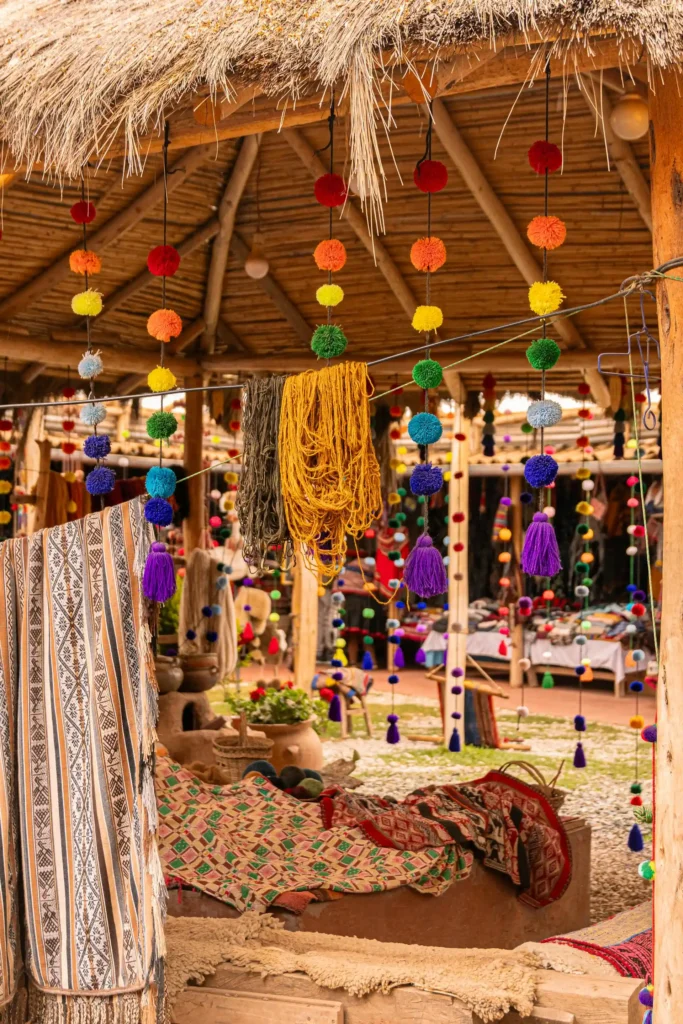
What to See in Chinchero?
In Chinchero, you will find a rich blend of history, culture, and nature. Below, we provide more details about the main tourist attractions of this charming town:
Main Square
Chinchero’s main square is the heart of the town and an ideal place to start your visit. It features various historical and cultural elements, such as the arches and niches that were used by the Incas.
The Arches of the Main Square
The arches of the square are a remnant of colonial architecture and form a harmonious ensemble with the Inca structures. These arches, with a simple yet imposing design, reflect the Spanish influence in the town.
The 12 Niches
In the square, you will also find 12 niches, which were used to place figures and ceremonial objects. These niches represent the cultural syncretism between Andean traditions and the Catholic religion introduced during colonization.
Temple of Our Lady of Monserrat
The Church of Our Lady of Montserrat stands on the ruins of an Inca palace and is a clear example of the fusion of Inca and Spanish cultures. Built in the 16th century, this church showcases colonial architecture with a striking facade, but the most remarkable feature lies inside.
The church houses colonial frescoes and paintings that incorporate elements of Andean iconography, reflecting the blend of beliefs and traditions between indigenous peoples and colonizers. The church is located in the heart of Chinchero and is an important symbol of the town’s history.
The Kallankas
These are large buildings that served as lodging and meeting spaces during the Inca era. In Chinchero, these structures have been preserved and represent an important part of the archaeological site.
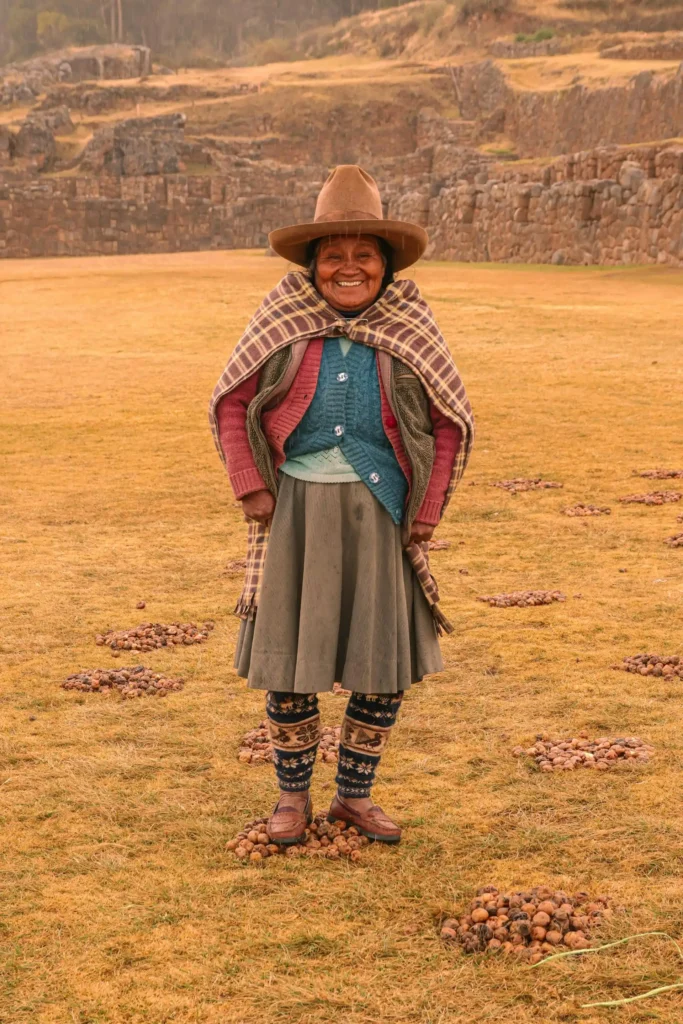
Wakas Pumaqaqa and Teteqaqa
The wakas, or sacred sites, such as Pumaqaqa and Teteqaqa, are places of worship in Andean culture. These spaces were used for offerings and rituals in honor of Pachamama (Mother Earth) and other sacred elements of the Inca worldview.
Andenes or Agricultural Terraces
The agricultural terraces are an example of the Incas’ ability to adapt farming to mountainous terrain. These terraces allowed cultivation at different altitudes and optimized water usage, making them an advanced agricultural system.
Chinchero Textile Centers
The Chinchero Textile Center is a must-visit for those who want to learn more about traditional Andean weaving techniques. Here, visitors can see the complete process of fabricating alpaca and sheep wool textiles, from spinning to dyeing with natural products such as plants, insects, and minerals. Local artisans demonstrate ancestral techniques, including the use of backstrap looms to create garments such as blankets, ponchos, and shawls. The center also offers the opportunity to purchase some of these products directly from the artisans, ensuring that you are acquiring authentic, handmade pieces.
